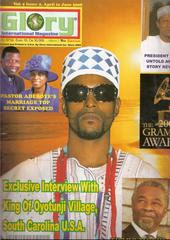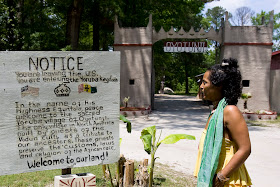 | |
| ADEFUNMI II (NEW KABAYESI,SON OF THE FOUNDING KABAYESI) |
OYO TUNJI: A YORUBA COMMUNITY IN THE USA
Religious beliefs and ceremonies, visual culture, and social organization closely based on traditional Yoruba prototypes from Nigeria and Benin Republic are embraced by African American members of Oyo Tunji in Beaufort County, South Carolina, as viable alternatives to mainstream American culture. Oyo Tunji (“Oyo Returns” or “Oyo Rises Again”) is a metaphor for the reconstruction, in the United States, of the ancient kingdom of old Oyo, which flourished in Nigeria (c.1600 to 1830 CE).
Oyo Tunji is popularly referred to as “the African village.” The current leader, known as Oba (king) Efuntola Oseijeman Adefunmi I, along with a handful of priests and priestesses, established Oyo Tunji in 1970, near the town of Sheldon, where routes 17 and 21 intersect. Oyo Tunji is, first and foremost, a religious community. The primary criterion of membership is initiation into “Yoruba” religion, which, in fact, while foregrounded there, accommodates an intertextual blend of borrowing from other African religions including Fon, Asante, Edo (ancient Benin kingdom), and ancient Egyptian. The king’s name is an excellent example of the .influence of multiple African elements: Efuntola signifies his initiation into Yoruba religion as a priest of Obatala (in Nigeria, the Yoruba deity credited with human creation through his modeling of human bodies from primordial clay). Efun in Yoruba is white chalk and ola denotes abundance. Oseijeman (or “savior of the people” in Akan) is a customary name for chiefs in Ghana. Adefunmi (“crown for me”) builds upon the Yoruba traditional of designating all royal lineage families by prefixing their names with ade (“crown”). Funmi is a conscious signifier of Oyo Tunji’s king’s (formerly Walter Serge Roy King of Detroit, Michigan) proactive appropriation of Yoruba royal names and a conceptual pun on his “slave” name. Adefunmi can thus be seen as a “New World” oriki (Yoruba praise name) that puns on the fact that Walter Serge Roy King originated the “kingdom” of Oyo Tunji and created a royal lineage for himself and his family, with the right to rule and wear the crown (ade, the sign par excellence of royalty among the Yoruba in West Africa).
A very large number of African American men and women have been initiated in Oyo Tunji by Kabiyesi (Yoruba, “royal highness”) Queen Iy Orite and others since 1970. These priests and priestesses maintain close and continuous ties with the community, although many have chosen not to remain permanently in Oyo Tunji. They have dispersed throughout the United States to found small religious satellites of Oyo Tunji in Chicago, Indiana, Wisconsin, New York, Virginia, Florida, and Los Angeles. The major deities (orisha) are conceived as embodiments of organic, supernatural, and mortal power that often calibrate with numerology and astrology. Thus, Orunmila (while equated with the domain of Ifa divination among the Yoruba in Africa) is associated with the Sun. Olokun (a deity associated with rulership and wealth in the ancient Nigerian Benin kingdom) is identified with the planet Neptune and the sign Pisces. In Oyo Tunji, Olokun is also conceptualized as the] deity representing the souls of all descendants of Africans transferred from their homeland by ships sailing the Atlantic Ocean and, as such, serves as the patron deity of all African Americans. Obatala (the creation deity who first molded humans from earth) is the patron deity of Oyo Tunji and the one with the most initiates. Obatala is linked with the planet Jupiter and the sign Sagittarius. Sango (whose domain is thunder and who was a former king of old Oyo, an ancient Yoruba city) is governed by Uranus and linked to Aquarius. Yemoj (the mother of deities not born by Nanan), seen in Oyo Tunji as a powerful iyami (enchantress), governs the Gelede society organized by men to honor elderly women of tremendous spiritual authority. As a moon goddess, Yemoj is connected with the sign of Cancer and the numbers 4 and 7. Esu-Elegba, the prankster, is seen as, simultaneously, the youngest and the oldest of all the deities. He is linked to the planet Mercury, the signs Gemini and Virgo, and the numbers 1, 3, 11, and 21. His domains are the marketplace and the crossroads. He possesses the spiritual force to open and close roads and place or remove obstacles, all metaphors for positive or negative opportunities and success or failure.
In Oyo Tunji, a separate temple complex exists for each deity, which includes the main shrine, a smaller shrine for the Esu-Elegba of the deity, and a building where initiates are housed during their seclusion. Priests and priestesses function as diviners and herbalists who provide guidance for the inhabitants of Oyo Tunji, as well as visitors or local South Carolinians. They combine healing with herbs, fasting, divination, palmistry, tarot cards, numerology, and astrology.
Known ancestors are honored by paintings, photos, and Egungun cloth ensembles, as in Africa, while unknown ancestors are determined by roots-reading divinations and honored by fresh water, flowers, candles, and prayers. An innovation introduced in Oyo Tunji is the initiation of women into the Egungun society.
Finally, the visual culture of Oyo Tunji exemplifies a deliberate creative project that departs from the mainstream, exhibition-directed arts created by many African American artists, who position themselves within the American mainstream. In contrast, Oyo Tunjians look toward conventional Yoruba art forms still commonplace in the African homeland and available through African art books, journals, or early ethnographies.
In sum, Oyo Tunji occupies a unique place among African diaspora communities; it is a uniquely intellectual entity, consciously created by African Americans as a counterpoint to, and revitalization effort within, mainstream American society and culture. Rooted in West African Yoruba religious, sociopolitical, and artistic epistemologies, Oyo Tunji testifies to the agency and activity of African Americans in the diaspora.
References
Gregory, Steven. 1999. Santeria in New York City: A Study in Cultural Resistance. New York: Garland.
Murphy, Joseph M. 1988. Santeria: An African Religion in America. Boston: Beacon Press.
——. 1994. Working the Spirit: Ceremonies of the African Diaspora. Boston: Beacon Press.
Hunt, Carl. 1979. Oyo Tunji, Ph.D. dissertation, University of Virginia.
Ojo, G.J.A. 1966. Yoruba Culture: A Geographical Analysis. London: University of London Press.
Omari, Mikelle Smith. 1984. From the Inside to the Outside: The Art and Ritual of Bahian Candomble. Monograph Series no. 24. Museum of Cultural History, University of California, Los Angeles.
——. 1989. The Role of the Gods in Afro-Brazilian Ancestral Ritual: African Arts Journal XXIII, no. 1.
——. 1990. Creativity in Adversity: Afro-Bahian Women, Power, and Art. The International Review of African American Arts 9, no.1:35–41.
——. 1991. Completing the Circle: Notes on African Art, Society, and Religion in Oyo Tunji, South Carolina. African Arts, July, 66–75, 96.
——. 1994. Aesthetics and Ritual of Candomble Ago. In African Religions: Experience and Expression, ed., Thomas Blakely, pp. 135–9. London: James Curry; Portsmouth, N.H.: Heineman.
——. 2002. Manipulating the Sacred: Yoruba Art, Ritual and Resistance in Brazil. Detroit: Wayne State University Press.
Pinn, Anthony. 1998. Varieties of African American Religious Experience. Minneapolis: Fortress Press.
MIKELLE SMITH OMARI-TUNKARA




No comments:
Post a Comment